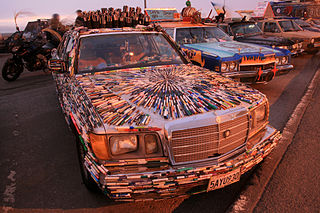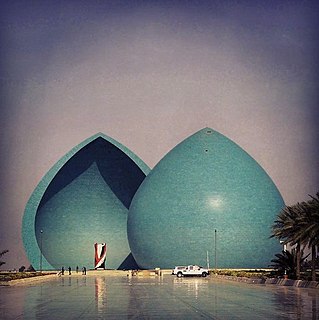Related Research Articles

An art car is a vehicle that has had its appearance modified as an act of personal artistic expression. Art cars are often driven and owned by their creators, who are sometimes referred to as "Cartists".

Environmental art is a range of artistic practices encompassing both historical approaches to nature in art and more recent ecological and politically motivated types of works. Environmental art has evolved away from formal concerns, for example monumental earthworks using earth as a sculptural material, towards a deeper relationship to systems, processes and phenomena in relationship to social concerns. Integrated social and ecological approaches developed as an ethical, restorative stance emerged in the 1990s. Over the past ten years environmental art has become a focal point of exhibitions around the world as the social and cultural aspects of climate change come to the forefront.

Jewad Selim (1919–1961) was an Iraqi painter and sculptor born in Ankara, Ottoman Empire in 1919. He became an influential artist through his involvement with the Iraqi Baghdad Modern Art Group, which encouraged artists to explore techniques that combined both Arab heritage and modern art forms. He is considered to be one of Iraq's greatest 20th-century sculptors.

Suad al-Attar is an Iraqi painter whose work is in private and public collections worldwide, including The British Museum and the Gulbenkian Collection. She has held over twenty solo exhibitions, including one in Baghdad that became the first solo exhibition in the country's history for a woman artist. Her many awards include the first prize at the International Biennale in Cairo in 1984 and an award of distinction at the Biennale held in Malta in 1995.
Ahmed Al Safi is an Iraqi sculptor and painter.
Arnold Mikelson (1922-1984) was a Latvian artist who specialized in wood carvings. Starting in 1947, he was chief designer for Royal Crown Derby Porcelain of England, before working as an architectural draftsman for a number of years. In the late 1960s, he took up carving full-time. Mikelson's work includes the design of the Mind and Matter Gallery in White Rock, British Columbia. He had commissions from the forestry giant MacMillan Bloedel, the Province of British Columbia and the City of Surrey.

Ismail Fatah Al-Turk was an Iraqi painter and sculptor born in Basra, Iraq, noted for his abstract art, monumental sculpture and public works and as part of the Baghdad Modern Art Group, which fostered a sense of national identity. His monument, al-Shaeed is the most iconic public monument in Baghdad.

Gerry Judah FRSS is a British artist and designer who has created settings for theatre, film, television, museums and public spaces.
Mohammad Ghani Hikmat was an Iraqi sculptor and artist credited with creating some of Baghdad's highest-profile sculptures and monuments and was known as the "sheik of sculptors". He is also known as an early member of Iraq's first 20th-century art groups, including Al-Ruwad and The Baghdad Modern Art Group; two groups that helped to bridge the gap between tradition and modern art. He was also instrumental in recovering many of Iraq's missing artworks, which were looted following the 2003 invasion.

Kim Victoria Abeles is an American interdisciplinary artist and professor emeritus currently living in Los Angeles. She is described as an activist artist because of her work's social and political nature. She is also known for her feminist works. Abeles has exhibited her works in 22 countries and has received a number of significant awards including a Guggenheim Fellowship. Aside from her work as an artist, she was a professor in public art, sculpturing, and drawing at California State University, Northridge from 1998 to 2009, after which she became professor emerita in 2010.
The Qatar Museums (QM) Public Art Department is responsible for overseeing the installation of artwork by renowned artists in the public realm in Qatar, creating an artist residency program for young local artists to help them develop their skills and horizons, organizing exhibitions featuring international artists and developing an online community of creative talent in Qatar and beyond. The QM has an ambitious plan that aims to make Qatar a world class cultural destination, notably in modern and contemporary art.
Hanaa Malallah is an Iraqi artist and educator living in London, England. Her surname also appears in English as Mal-Allah. She is noted for developing the technique called the Ruins Technique in which found objects are incorporated into artwork.

Mahmoud Obaidi is an Iraqi-Canadian artist whose work has been exhibited in museums and galleries around the world.
Muqbil Al-Zahawi is an Iraqi ceramicist. His creative and powerful sculptures and reliefs have been exhibited in museums, galleries, international shows, studios, and private residences throughout the U.S., Western Europe, and the Middle East. Al-Zahawi's works derive inspiration from African Art, select Western artists, and his background as an Iraqi Muslim.

Iraqi art is one of the richest art heritages in world and refers to all works of visual art originating from the geographical region of what is present day Iraq since ancient Mesopotamian periods. For centuries, the capital, Baghdad was the Medieval centre of the literary and artistic Arab world during the Abbasid Caliphate, in which Baghdad was the capital, but its artistic traditions suffered at the hands of the Mongol invaders in the 13th century. During other periods it has flourished, such as during the reign of Pir Budaq, or under Ottoman rule in the 16th century when Baghdad was known for its Ottoman miniature painting. In the 20th century, an art revival, which combined both tradition and modern techniques, produced many notable poets, painters and sculptors who contributed to the inventory of public artworks, especially in Baghdad. These artists are highly regarded in the Middle East, and some have earned international recognition. The Iraqi modern art movement had a profound influence on pan-Arab art generally.
Ahmed Albahrani, is an Iraqi sculptor. He is one of the most famous Iraqi sculptors, now living in exile.
Khaled Al-Rahal was an Iraqi painter and sculptor and one of the leaders of the modern art movement in Iraq. Described as one of the "pillars of modern Iraqi art," he was responsible for executing a number of high-profile public monuments in Baghdad in the mid-20th century.
Lorna Selim (1928-2021) was an English artist and art teacher, who married prominent Iraqi sculptor Jewad Selim, relocating to Baghdad with him in 1950. She was a practising artist for much of her life up until her death. Selim contributed to the arts community in Iraq through her exhibitions, teaching and active participation in arts groups for twenty years. After her husband's premature death in 1961, she was part of the team responsible for completing his iconic monumental work, entitled Nasb al-Hurriyah.
Amer al-Obaidi is an Iraqi-born painter, now residing in the United States, who is noted for artwork that emphasises Iraqi folklore and tradition.
Sadik Kwaish Alfraji is an Iraqi multi-media artist, photographer, animator, video producer and installation artist noted for producing "existentialist" works with dark, shadowy figures that speak of human frailty.
References
- 1 2 "The nature of peace". Victoria News . 26 March 2013. Retrieved 29 March 2013.